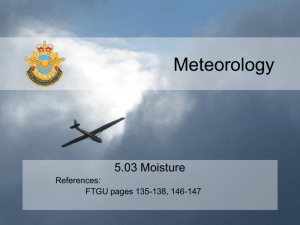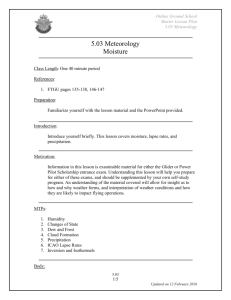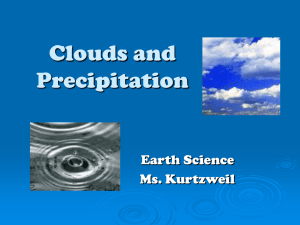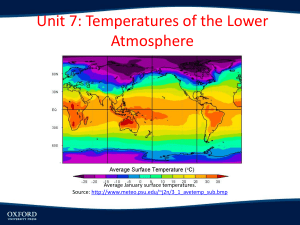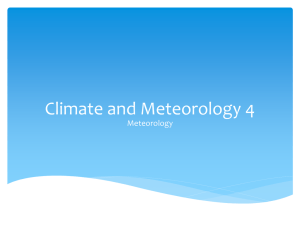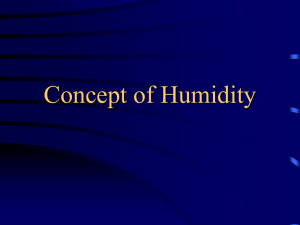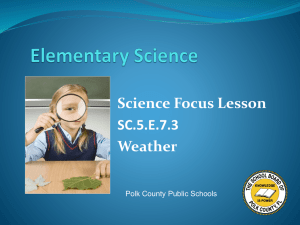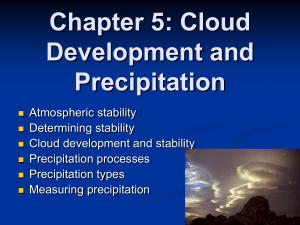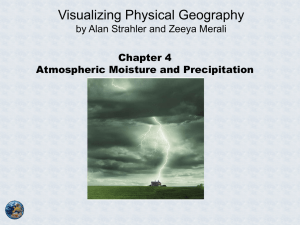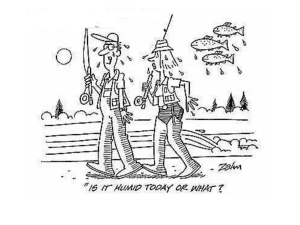5.03 Moisture - 94aircadets.ca
advertisement
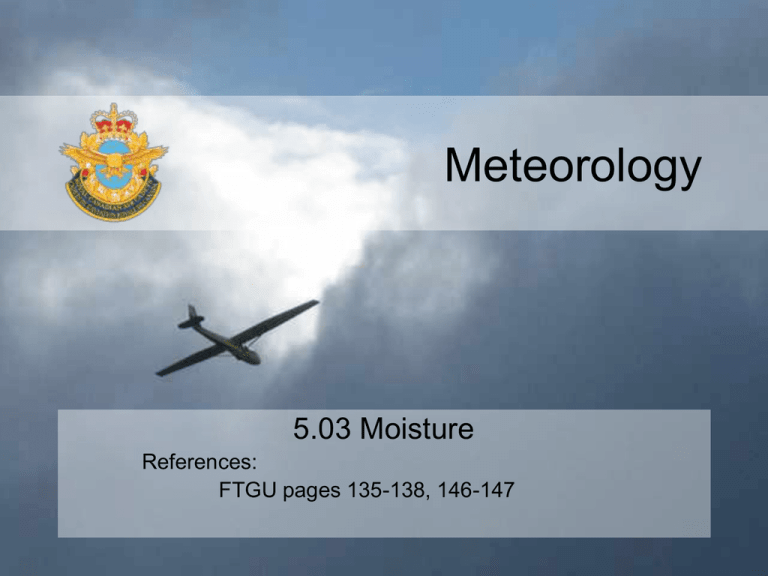
Meteorology 5.03 Moisture References: FTGU pages 135-138, 146-147 5.03 Moisture • MTPs: – Humidity – Changes of State – Dew and Frost – Cloud Formation – Precipitation – ICAO Lapse Rates – Inversion and Isothermals Humidity • Relative Humidity – Ratio of water present in air compared to the amount the same volume could hold if it were saturated • Dew Point – Temperature to which air must be cooled at constant pressure to become saturated Humidity • The warmer the air, the more water vapour it can hold...Why? 1 kg air at 0 degrees = 5g water 1 kg air at30 degrees = 30g water Humidity • Example – If we took a parcel of air at 10oC at 100% relative humidity and warmed it up, how would the relative humidity change? Confirmation • Define Relative Humidity • Define Dew Point Changes of State • • • • • Freezing Evaporation Melting Sublimation Condensation Changes of State Confirmation 1. What do you call a change of state from liquid to solid? 2. From solid to gas? 3. From vapour to liquid? Dew and Frost • Dew and Frost form on clear, still nights • Vegetation and other objects cool by radiation below the dewpoint • If the dewpoint is above freezing, dew will form by condensation • If the dewpoint is below freezing, frost will form by sublimation Cloud Formation • Invisible water vapour becomes visible as water droplets or ice • Condensation of water vapour Cloud Formation • What is required: – High relative humidity – Condensation nuclei – Cooling of the air • Cold surface • Adiabatic cooling Cloud Formation • Steps – Air is heated and rises – Air cools to point of saturation – Air condenses onto condensation nuclei Confirmation • What are the three things required for cloud formation? Precipitation • Water droplets grow in size and weight and fall due to gravity – Can also occur below freezing (water vapour and ice crystals) The average rain drop is a million times larger than a cloud water droplet Precipitation If the cloud is….. • Below freezing – joining of ice crystals • Above freezing = rain • If temp below is cold enough to allow crystals to fall to ground = snow Precipitation • Regions of a cloud • Snow • Rain and/or snow • Rain • Large drops and heavy rain = strong vertical motion Precipitation Types of precipitation • Drizzle – very small drops of water which appears to float • Rain – Large water droplets Precipitation • Hail – Hard transparent layer of ice covering soft white core • Snow Grains – Tiny snow crystals that have acquired a coating of rime Precipitation • Snow Pellets – Soft white ice (hail without hard transparent layer • Snow – Agglomeration of ice crystals hexagonal/star shaped Precipitation • Ice Prisms – Tiny ice crystals in the form of needles • Ice Pellets – Formed by freezing of raindrops Confirmation • What are the 8 different types or precipitation? ICAO Lapse Rates • Lapse rate – Rate of decrease in temperature with altitude ICAO Lapse Rate • Lapse rates: Dry Adiabatic 3.0 °C / 1000 ft Saturated Adiabatic 1.5° C / 1000 ft Standard 2.0 °C / 1000 ft ICAO 1.98 °C / 1000 ft • Recall ICAO Standard Atmosphere: – Air is perfectly dry gas – Mean sea level pressure of 29.92 – Mean sea level temp of 15°C ICAO Lapse Rates • Can determine base of clouds: – – – – Temperature on ground 10 degrees Dew point 7 degrees Lapse Rate Dry Adiabatic (3°C/1000 ft) Cloud base = 1000 feet Inversion and Isothermals • There are exceptions to standard lapse rates • Inversion – Increase in temperature with altitude • Isothermal Layer – Layer in which temperature remains the same • Both these conditions produce stability. More on this in 5.05 Confirmation 1. What is the dry adiabatic lapse rate? – _____ degrees per _________feet 2. What is hail? 3. A parcel of air has a relative humidity of 50%. If the temperature were to decrease how would the relative humidity change? Rain on the Beach
